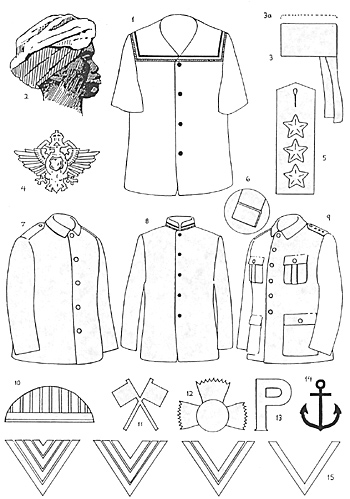
The non-German force consisted of six Sudanese companies of 100 men each, one Zulu company also of 100 men, a unit of Company askaris (60-80 men), 30 Sudanese artillerymen, 40 Somali sailors, and 22 Turks for police (twenty men and two officers).
The Sudanese soldiers wore a khaki jackey with brass buttons (7), khaki knee-length trousers, blue puttees, and natural color leather lace-up shoes. On their head they wore a light gray or pale yellow turban wound around a fez (2). Toward the end of 1890 the turban was changed to a gray tarboosh and neckshade (3).
The Effendis (native officers) wore a khaki jacket (9) after the pattern worn by German nco's, with trousers, puttees, shoes, and headress as for the soldiers. Their jacket buttons were brass also.
The designation "Effendi" originated during the time of the Wissmann Unit. The equivalent German rank was Leutnant or Second Lieutenant. For insignia they wore three, golden, five-pointed stars on each shoulder strap (5).
Rank among the men was denoted by chevrons (15). These were of blue braid (Zinnfigur mentions that some sources state yellow) and worn on the right forearm of the khaki jacket. From 1890 onward they were red, and worn on the upper left sleeve. One chevron denoted the rank of "Ombascha" (Gefreite, or Lance Corporal), two chevrons denoted the rank of "Schausch" (Unteroffizier, or Corporal), three denoted the rank of "Betschausch" (Sergeant), and four the rank of "Sol" (Feldwebel, or Sergeant-Major). Askaris (Privates) wore none.
Specialist badges were worn on the upper right sleeve of the jacket. There was a red flaming grenade (12) for artillerymen, and red crossed flags (11) for signals personnel.
Soldiers of the Zulu company wore the same dress as the Company askaris mentioned earlier, but the jacket (1) and knee-length trousers were blue instead of white, and the jacket was worn outside the trousers. For parade they wore a long-sleeved white shirt beneath the jacket, and white puttees. According to Zinnfigur, later, when a second company was added, the soldiers of the second company wore a white tassel on their fez as a distinction. At the end of 1889 the Zulu soldiers were given the same sort of dress as the Sudanese; with the exception of headwear as they continued to wear the fez, and the lack of shoes.
The German East Africa Company askaris continued to wear their white uniform and fez. A photo in Schmidt dated 1889 shows a group of them wearing a waistbelt with belly box and their jacket is being worn outside the trousers. Zinnfigur states that during the period of the Wissmann Unit a white jacket (8) with standing collar and black buttons came to be worn with long white trousers; jacket outside. There was a black-white-red braid running along the base of the collar.
Uniforms of Native Troops in German East Africa
- Introduction
German East Africa Company
The Wissmann Unit
Native Sailors
Village Police
Imperial Protective Force
Sources
Back to The Heliograph's German Colonial Military Uniforms: Africa Table of Contents
Back to The Heliograph List of Issues
Back to Master Magazine List
© Copyright 2003 by Richard Brooks.
This article appears in MagWeb.com (Magazine Web) on the Internet World Wide Web.
Other articles from military history and related magazines are available at http://www.magweb.com